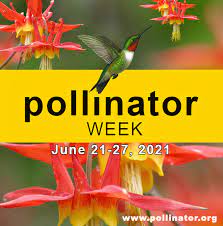
by Sheila Dunning | Jun 10, 2021
Are you one of those that hear the word “pollen” and sneeze? For many, allergies are the only association with plant pollen. But pollination – the transfer of male pollen grains into the female flower organs to create fertile seeds – is an essential part of a healthy ecosystem. Pollinators play a significant role in the production of over 150 food crops. Corn and rice are wind pollinated. Just about everything else, including chocolate, depends on an insect, bird or mammal. Successful pollination of a single flower often requires visits from multiple pollinators. But, there are also plants that need a specific species in order to complete the task. They are so interdependent that if one disappears, so will the other.
Unfortunately, reports from the National Research Council say that the long-term population trends for some North American pollinators are “demonstrably downward”.
 In 2007, the U.S. Senate unanimously approved and designated “National Pollinator Week” to help raise awareness. National Pollinator Week (June 21-27, 2021) is a time to celebrate pollinators and spread the word about what you can do to protect them. Habitat loss for pollinators due to human activity poses an immediate and frequently irreversible threat. Other factors responsible for population decreases include: invasive plant species, broad-spectrum pesticide use, disease, and weather.
In 2007, the U.S. Senate unanimously approved and designated “National Pollinator Week” to help raise awareness. National Pollinator Week (June 21-27, 2021) is a time to celebrate pollinators and spread the word about what you can do to protect them. Habitat loss for pollinators due to human activity poses an immediate and frequently irreversible threat. Other factors responsible for population decreases include: invasive plant species, broad-spectrum pesticide use, disease, and weather.
So what can you do?
- Install “houses” for birds, bats, and bees.
- Avoid toxic, synthetic pesticides and only apply bio-rational products when pollinators aren’t active.
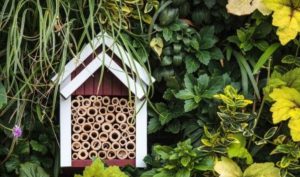
- Provide and maintain small shallow containers of water for wildlife.
- Create a pollinator-friendly garden.
- Plant native plants that provide nectar for pollinating insects.
There’s a new app for the last two.
The Bee Smart® Pollinator Gardener is your comprehensive guide to selecting plants for pollinators based on the geographical and ecological attributes of your location (your ecoregion) just by entering your zip code. http://pollinator.beefriendlyfarmer.org/beesmartapp.htm
Filter your plants by what pollinators you want to attract, light and soil requirements, bloom color, and plant type. This is an excellent plant reference to attract bees, butterflies, hummingbirds, beetles, bats, and other pollinators to the garden, farm, school and every landscape.
The University of Florida also provides a website to learn the bee species and garden design. Go to: https://ffl.ifas.ufl.edu/bees/Bee
or go on-line to see a list of pollinator-attracting plants. https://gardeningsolutions.ifas.ufl.edu/design/gardening-with-wildlife/bee-plants.html
Not only can you find out which plants attract pollinators, you will be given the correct growing conditions so you can choose ‘the right plant for the right place’.
Remember, one out of every three mouthfuls of food we eat is made possible by pollinators.

by Sheila Dunning | May 6, 2021
Some very exciting things have come from all the computer time that COVID-19 forced upon the University of Florida technology specialists – new updated websites. If you haven’t searched for UF publications or Florida-Friendly Landscaping advice in a while, you will be pleasantly surprised at what is available.
 UF/IFAS has had a long history of providing electronic access to publications, beginning in the early 1990s when it began producing handbooks of documents on CD-ROMS. By the mid-90s the Florida Agricultural Information Retrieval System (FAIRS) website went online. In 1998, the name was changed to Extension Data Information Source (EDIS) to reflect changes in its scope and function. EDIS became the single source for all Extension publications and was also adapted to permit Extension units to print documents on an as-needed basis. More recently in 2006, the UF/IFAS Solutions for Your Life web initiative has brought EDIS publications together with other valuable web resources. Now, after 25 years as a valuable online resource from UF/IFAS, the EDIS website has been rebranded as Ask IFAS. The new site is modern, mobile-friendly and will make Extension publications even easier to find. There are many new features including videos and two Ask IFAS specific indexes: Experts and Topics. The new indexes enable users to find contact information for specific agents and specialists by their name or department. Information by individual topics is easier to search also. Ask IFAS carries on EDIS’ role as a comprehensive, single-source repository of all current UF/IFAS numbered peer-reviewed publications. Each year, visitors to the EDIS website access one of over 6,500 publication titles more than 17.5 million times.
UF/IFAS has had a long history of providing electronic access to publications, beginning in the early 1990s when it began producing handbooks of documents on CD-ROMS. By the mid-90s the Florida Agricultural Information Retrieval System (FAIRS) website went online. In 1998, the name was changed to Extension Data Information Source (EDIS) to reflect changes in its scope and function. EDIS became the single source for all Extension publications and was also adapted to permit Extension units to print documents on an as-needed basis. More recently in 2006, the UF/IFAS Solutions for Your Life web initiative has brought EDIS publications together with other valuable web resources. Now, after 25 years as a valuable online resource from UF/IFAS, the EDIS website has been rebranded as Ask IFAS. The new site is modern, mobile-friendly and will make Extension publications even easier to find. There are many new features including videos and two Ask IFAS specific indexes: Experts and Topics. The new indexes enable users to find contact information for specific agents and specialists by their name or department. Information by individual topics is easier to search also. Ask IFAS carries on EDIS’ role as a comprehensive, single-source repository of all current UF/IFAS numbered peer-reviewed publications. Each year, visitors to the EDIS website access one of over 6,500 publication titles more than 17.5 million times.
The deactivated_site website will soon be taken down. But, the nine principles, plant database and recorded useful information has been updated and posted on the Florida-Friendly Landscaping site.  https://ffl.ifas.ufl.edu/. Information is organized by specific user groups, such as Home Landscapes, Community Landscape and Landscape Professionals. By utilizing the appropriate category, individuals can submit questions, join webinars and locate Florida-Friendly Certified Professionals. Okaloosa and Bay counties have individuals that have completed the required training. The criteria for earning Florida-Friendly status for residential or commercial landscapes is outlined on the website as well. All nine principles provide tips on ways to apply practical techniques in any landscape. Florida-Friendly Landscaping™ in a Minute is a one-minute radio show that shares practical tips on Florida-Friendly Landscaping™ based on University of Florida horticultural research. The show airs twice every weekday and all shows are supported with helpful online links for more information. Shows are recorded for any time viewing at a later date. Finally, the Florida-Friendly Plant Guide can be tailored by zip code and the app for your phone is free to download. https://ffl.ifas.ufl.edu/resources/apps/. There is even a toxic plant and butterfly garden app.
https://ffl.ifas.ufl.edu/. Information is organized by specific user groups, such as Home Landscapes, Community Landscape and Landscape Professionals. By utilizing the appropriate category, individuals can submit questions, join webinars and locate Florida-Friendly Certified Professionals. Okaloosa and Bay counties have individuals that have completed the required training. The criteria for earning Florida-Friendly status for residential or commercial landscapes is outlined on the website as well. All nine principles provide tips on ways to apply practical techniques in any landscape. Florida-Friendly Landscaping™ in a Minute is a one-minute radio show that shares practical tips on Florida-Friendly Landscaping™ based on University of Florida horticultural research. The show airs twice every weekday and all shows are supported with helpful online links for more information. Shows are recorded for any time viewing at a later date. Finally, the Florida-Friendly Plant Guide can be tailored by zip code and the app for your phone is free to download. https://ffl.ifas.ufl.edu/resources/apps/. There is even a toxic plant and butterfly garden app.
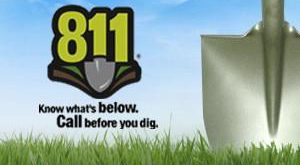
by Sheila Dunning | Apr 1, 2021
 Call 811 before you dig. No one wants a weekend project to be the cause of internet, phone and cable outages. Worse yet, what if someone gets hurt from contact with natural gas or electrical lines? That’s why it is so important to have buried utilities in the yard located and marked before digging. Sunshine 811 coordinates each individual company to clearly mark where the service lines are located. Homeowners are required by law to contact 811 three days before any soil removal is done. The service is free.
Call 811 before you dig. No one wants a weekend project to be the cause of internet, phone and cable outages. Worse yet, what if someone gets hurt from contact with natural gas or electrical lines? That’s why it is so important to have buried utilities in the yard located and marked before digging. Sunshine 811 coordinates each individual company to clearly mark where the service lines are located. Homeowners are required by law to contact 811 three days before any soil removal is done. The service is free.
Have information prepared before making the request. Describe the work to be performed (e.g. fence install, landscaping, irrigation install), including the type of equipment that will be used. Specify the exact location on the property and how long the work will continue. Finally, provide all the contact information (e.g. name, phone number, e-mail), should there be any additional questions.
Call 811 or request a single address ticket online. Receive a ticket number and wait two full business days, not counting weekends or holidays. Then contact 811 again. Make sure that all the utilities have responded in the Positive Response System (PRS). Sometimes that may mean that the company doesn’t have anything to make in the area.
If there are utility lines running through the yard, they will be marked with specifically colored paints or flags. Red is used for electrical lines, orange indicates communication lines, yellow means gas, blue is used for potable water, purple is reclaimed water, and green indicates sewer lines. White lines may be used to outline digging areas and pink are temporary survey marks. This is the APWA Uniform Color Code.
Every effort is made to locate the lines as accurately as possible. But, the safest thing to do is hand dig to expose the utility line before using any mechanized equipment. Lines can vary up to 24” from the marked line and depths can be less than 5”. Remember there may be access lines running through the property even if that service isn’t utilized at that address.
Keep safe this spring. Call 811 before digging.
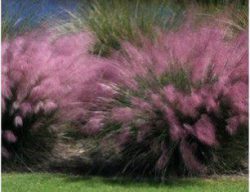
by Sheila Dunning | Feb 18, 2021
The term “ornamental grass” is a catch-all phrase used to describe grasses and “grass-like” plants. Individual species are adapted to a wide variety of landscape sites (i.e., wet or dry, sun or shade, hot or cold climates, and varied salt tolerance). Growth habits range from low ground covers to intermediate shrub-like plants to very tall hedge-like plants. Ornamental grasses are very dynamic; the size, shape, texture, and color of grass changes with every season.
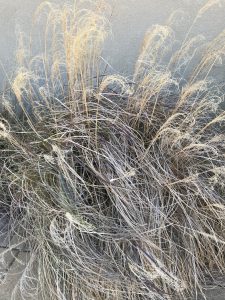
Deciduous Ornamental Grass
Grasses with foliage that dies in the winter and remains dormant until the weather warms in the spring are considered deciduous. The winter character of deciduous ornamental grasses adds tremendous interest to the winter garden when contrasted with evergreen plants or structures such as walls or fences. The dried foliage of deciduous grasses creates sound as it expands and contracts in response to changes in temperature or moisture, while interaction with wind creates movement in the garden. For these reasons, pruning of the dead foliage and inflorescences is not recommended at the time of the first frost.
Pruning of ornamental grasses should be done in late winter or early spring, just prior to new shoot growth. In Northwest Florida, gardeners should target the end of February to prune ornamental grasses. For deciduous grasses, such as Japanese silver grass (Miscanthus sinensis), the old foliage may be completely removed within inches of the soil. Be cautious to not remove the growth point by leaving the grass clump at least 4 inches high. For evergreen grasses, such as muhly grass (Muhlenbergia capillaris), the ragged leaves can be removed to neaten the appearance of the plant without shortening all the way to the ground. So, depending on the damaged portions, the remaining grass clump can be 6-18 inches high after pruning. Grasses recover quickly from a heavier pruning. Within a few months the plant will have completely regrown. If desired, old flower stalks and seed heads may be removed any time they no longer have a neat appearance. For more information on ornamental grass species and growing tips, please visit the EDIS Publication: Considerations for Selection and Use of Ornamental Grasses.
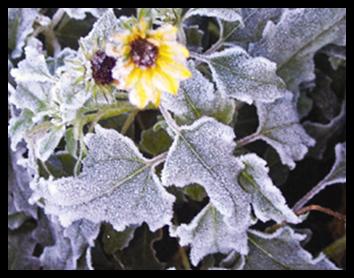
by Sheila Dunning | Dec 4, 2020
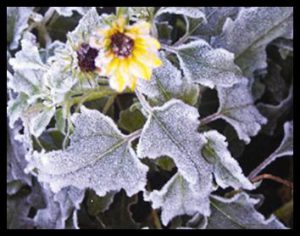
Frost on Dune Sunflower
Picture by: Pam Brown
UF/IFAS Extension
December is finally here and that means consistent nights of watching for dropping temperatures. Tropical plants and newly installed shrubs are susceptible to cold injury. Those colorful, blooming plants that have added a tropical look to the landscape all summer may begin to suffer when the temperatures drop below 500 F. Leaves may turn yellow and flowering stops. These plants will need to be moved inside or have temporary greenhouse built around them. But, hardy plants that haven’t established a sufficient root system will also need additional attention when the temperatures drop dramatically.
The ability of plants to endure a freeze depends on the species and the weather leading up to the extra cold night. Gradual decreases in temperatures helps plants acclimate to winter. But, a sudden one day drop of 40-50 degrees results in a rapid freeze that causes ice to form inside the plant cells. Leaf and stem tissue expands so quickly that it splits, resulting in parts of the plant incapable of transporting water and nutrients, as well as, performing photosynthesis. However, it may be late the following spring before the damage is noticed, when that section of the plant has slowly staved to death.

Cracked bark from frost
Additionally, plants can experience desiccation or drying out. This happens when dry winds and solar radiation result in the loss of more water from the leaves than can be transported by a cold root system. The resulting symptom is marginal and/or tip burning of leaves that leads to totally brown leaves.
Freezes (when the temperature drops to 320 F) are characterized as radiational or advective. Radiational freezes occur on calm, clear nights when heat radiates from the surfaces of plants, making them colder than the air due to the rapid loss of heat. If there is moisture in the air, ice will also form on the surfaces. Under these conditions, ice forms between plant cells, rather than within the individual cells. Most hardy plants can tolerate these type of freezes if they are properly hydrated.
Advective freezes occur when cold northern winds move in rapidly, dropping temperatures quickly, and causing widespread foliage desiccation. Cultivation and maintenance practices can impact a plant’s ability to endure extended periods of low temperatures. Shade-tolerant species installed under the canopy of a tree typically display less injury from radiational freezes because the trapped heat from the ground and the overhead foliage creates a microclimate. Well-watered soil around a plant will absorb solar radiation during the day and re-radiate heat over night, raising the temperature around the plants. Shrubs that are not pruned in the late summer or fall have leaves that can withstand frost and wind. But, the removal of foliage late in the growing season triggers a flush of new growth, that is very sensitive to lower temperatures. The same response can result from fertilizer applications after plant’s have slowed down in growth.
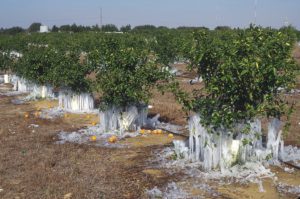
Irrigation Frost Protection on Citrus
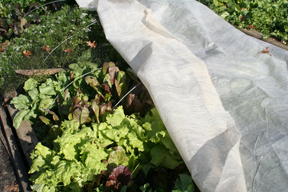
Row Cover
Picture by: Univ of Maryland Extension
So, what can you do to prepare for upcoming freezing temperatures? Begin by avoiding pruning and fertilizing at the end of the season and making sure that the plants have been watered within 24 hours of a cold night. Next, insulate against water loss and increase heat radiation by adding a three-inch of mulch, as well as, covering the trunks of sensitive trees with a commercial tree wrap. Then, consider what needs to be covered. Frost cloth or other breathable fabrics can trap heat for the night and provide a protective layer from frost settling on the leaves. It needs to be placed by mid-afternoon and removed the next day when temperatures are above 320 F. Plastic is not recommended unless the timing regime can be followed reliably and a structure is used under the material to keep the plastic off the foliage. Anchoring of the cover is critically important in the event of an advective freeze.
Finally, turn off the sprinkler system. Commercial agriculture often uses a running irrigation system to keep the leaf surface temperatures near, but not below, 320 F because sprinkling utilizes latent heat released when water changes from a liquid to a solid state. The thin layer of ice melts and re-freezes on the surface throughout the night, without ice forming within the plant tissues. For the technique to work, sprinkling must begin as freezing temperatures are reached and continue until thawing is complete. Landscape systems are not designed to deliver the amount of water over the length of time required to accomplish this type of frost protection.
When the cold nights have passed, don’t forget to check your plants for water. But, wait until winter has passed before pruning out the frost damaged stems.

 In 2007, the U.S. Senate unanimously approved and designated “National Pollinator Week” to help raise awareness. National Pollinator Week (June 21-27, 2021) is a time to celebrate pollinators and spread the word about what you can do to protect them. Habitat loss for pollinators due to human activity poses an immediate and frequently irreversible threat. Other factors responsible for population decreases include: invasive plant species, broad-spectrum pesticide use, disease, and weather.
In 2007, the U.S. Senate unanimously approved and designated “National Pollinator Week” to help raise awareness. National Pollinator Week (June 21-27, 2021) is a time to celebrate pollinators and spread the word about what you can do to protect them. Habitat loss for pollinators due to human activity poses an immediate and frequently irreversible threat. Other factors responsible for population decreases include: invasive plant species, broad-spectrum pesticide use, disease, and weather.











